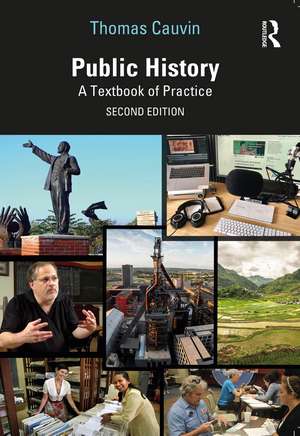Public History: A Textbook of Practice
Autor Thomas Cauvinen Limba Engleză Paperback – 19 mai 2022
Historians can play a dynamic and essential role in contributing to public understanding of the past, and those who work in historic preservation, in museums and archives, in government agencies, as consultants, as oral historians, or who manage crowdsourcing projects need very specific skills. This book links theory and practice and provides students and practitioners with the tools to do public history in a wide range of settings. This new edition reflects how much the field of public history has changed in the past few years, with public history now being more established and international. New chapters have therefore been added on the definition, history, and international scope of public history, as well as on specific practices and theories such as historical fictions, digital public history, and shared authority.
Split into four sections, this textbook provides approaches, methodologies, and tools for historians and other public history practitioners to play a bigger role in public debates and public productions of historical interpretations:
- Part I focuses on the past, present, and future of public history.
- Part II explores public history sources, and offers an overview of the creation, collection, management, and preservation of materials (archives, material culture, oral history, or historical sites).
- Part III deals with the different ways in which public history practitioners can produce historical narratives through different media (including texts, fictions, audio-visual productions, exhibitions, and performances).
- Part IV discusses the opportunities and challenges that public history practitioners encounter when working with different collaborators.
Preț: 342.08 lei
Nou
Puncte Express: 513
Preț estimativ în valută:
65.47€ • 67.63$ • 54.48£
65.47€ • 67.63$ • 54.48£
Carte disponibilă
Livrare economică 04-18 martie
Livrare express 18-22 februarie pentru 34.57 lei
Preluare comenzi: 021 569.72.76
Specificații
ISBN-13: 9780367473082
ISBN-10: 0367473089
Pagini: 302
Ilustrații: 15 Tables, black and white; 3 Line drawings, black and white; 27 Halftones, black and white; 30 Illustrations, black and white
Dimensiuni: 174 x 246 x 19 mm
Greutate: 0.5 kg
Ediția:2 ed
Editura: Taylor & Francis
Colecția Routledge
Locul publicării:Oxford, United Kingdom
ISBN-10: 0367473089
Pagini: 302
Ilustrații: 15 Tables, black and white; 3 Line drawings, black and white; 27 Halftones, black and white; 30 Illustrations, black and white
Dimensiuni: 174 x 246 x 19 mm
Greutate: 0.5 kg
Ediția:2 ed
Editura: Taylor & Francis
Colecția Routledge
Locul publicării:Oxford, United Kingdom
Public țintă
Postgraduate, Professional, Undergraduate Advanced, and Undergraduate CoreRecenzii
Praise for the 2nd edition:
The second edition of Public History: A Textbook of Practice offers a persuasive account of what public history is and how it is practiced. It makes a strong case for the importance of public history in today’s world and the role it can play in shaping our futures for the better.
- David Dean, editor of A Companion to Public History (2018).
Praise for the 1st edition:
Are you asking yourself what "public history" means? For the first time Thomas Cauvin describes the complex architecture of the field. This excellent textbook anticipates where the field is going internationally. All current debates are dealt with: cultural heritage, people’s history, media, the past exhibited, digital public history, the uses of the past, teaching, civic engagement, and more. The practice of history in public is now illuminated by the author’s capacity to jump from field to theory and back.
- Serge Noiret, President, International Federation for Public History, European University Institute
The second edition of Public History: A Textbook of Practice offers a persuasive account of what public history is and how it is practiced. It makes a strong case for the importance of public history in today’s world and the role it can play in shaping our futures for the better.
- David Dean, editor of A Companion to Public History (2018).
Praise for the 1st edition:
Are you asking yourself what "public history" means? For the first time Thomas Cauvin describes the complex architecture of the field. This excellent textbook anticipates where the field is going internationally. All current debates are dealt with: cultural heritage, people’s history, media, the past exhibited, digital public history, the uses of the past, teaching, civic engagement, and more. The practice of history in public is now illuminated by the author’s capacity to jump from field to theory and back.
- Serge Noiret, President, International Federation for Public History, European University Institute
Notă biografică
Thomas Cauvin is ATTRACT-Fellow and Associate Professor of Public History at the Centre for Contemporary and Digital History, University of Luxembourg. He leads the Public History as the New Citizen Science of the Past project (2020–2025) and was the President of the International Federation for Public History from 2018 to 2021.
Cuprins
0. Introduction Part I, Public history: Past, present, and future of the field 1. Defining public history 2. A long history of public history 3. Internationalization of public history 4. Collaboration, expertise, and authority: History with publics 5. Digital public history: a promising future Part II, Public history and sources 6. Museums and collections 7. Archiving 8. Historic preservation 9. Oral history Part III, Making public history 10. Public history writing 11. Historical fictions 12. Radio and audio-visual production 13. Exhibiting history 14. Immersion and performance Part IV, Collaboration, uses, and applications of public history 15. Public history teaching 16. Working with under-represented groups and communities 17. Public history, conflicts, and competing narratives 18. Business, policy, justice: Consulting and service
Descriere
The second edition of Public History: A Textbook of Practice offers an updated guide to the many opportunities and challenges that public history practitioners can encounter in the field.
